If you’ve been in the workforce for any length of time, then you have spent some serious time inside a conference or meeting room. While these spaces are adequate, they lack key elements that today’s employees need. With the shift to some hybrid and remote work, collaborative workspaces can be physical or digital, allowing teams to come together like never before.

Automate Your Work
Capacity’s enterprise AI chatbot can help:
- Answer FAQs anytime, anywhere
- Find relevant documents within seconds
- Give surveys and collect feedback
What is a collaborative workspace?
A collaborative workspace provides remote, hybrid, and in-person teams with a secure environment to solve problems and share information. With collaborative workspaces, tasks and objectives can be completed from anywhere, at any time.
The best collaborative workspaces create an environment where team members can come together to finish projects, brainstorm new strategies, and bond.
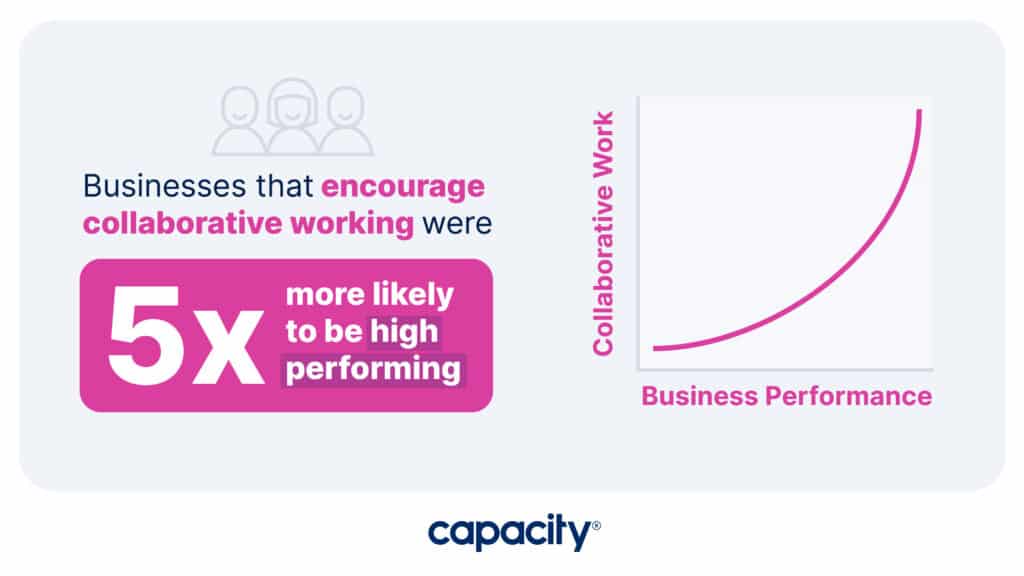
Why are collaborative workspaces important?
A shocking 39 percent of employees say people in their organization don’t collaborate enough.
Creating spaces where hybrid, remote, and in-person office workers can collaborate is crucial to success. Businesses that encourage collaborative working are five times as likely to be high performing.
Collaborative spaces can be physical, virtual, or a combination of both. An in-person office space that invites collaboration allows employees to brainstorm, strategize, and execute initiatives in real time. A great remote workspace enables employees to work together from wherever they live.
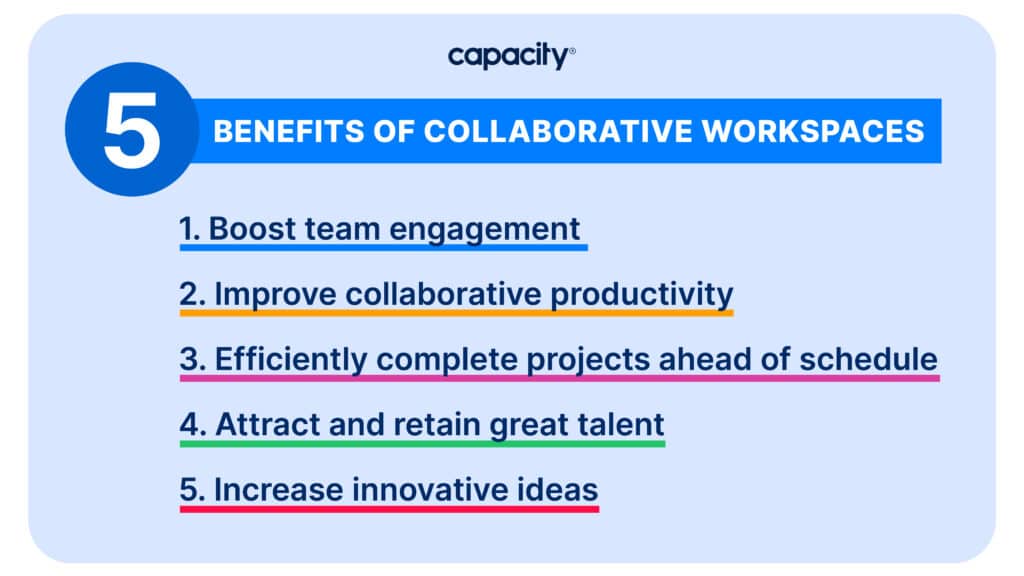
Top 5 benefits of collaborative workspaces
Collaborative spaces in offices offer several advantages for workers and employers alike.
1. Boost team engagement
Being in the same physical or virtual workspace as your colleagues strengthens the camaraderie. An engaged team is a happy team, and happy teams do better work.
Imagine a typical conference room with a table, chairs, and a blank wall. A modern collaborative workspace takes things further by adding engaging technology like large screens designed for video conferencing. Employees from any location can connect and collaborate seamlessly.
2. Improve collaborative productivity
How many tools do you use to connect to your colleagues? 60 percent of working adults use three or more daily tools to collaborate with their peers.
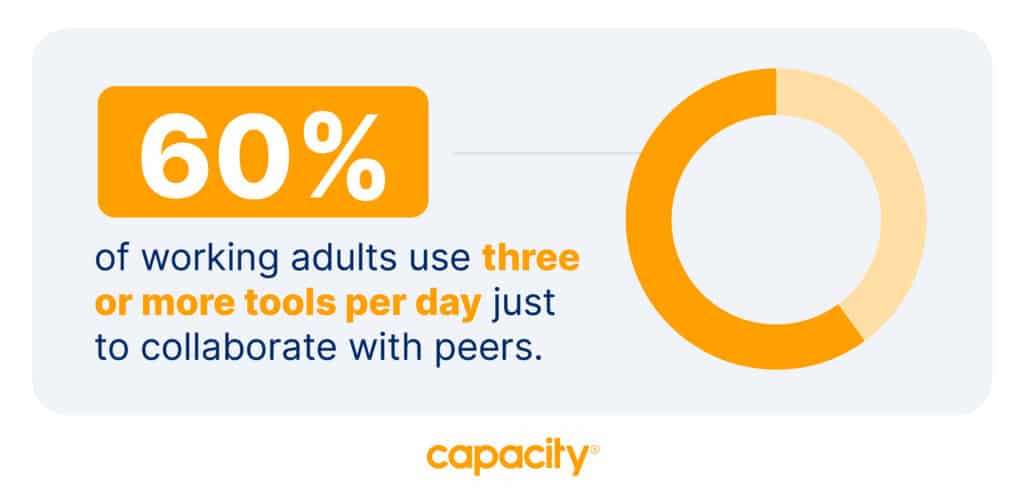
It’s easy to get caught up in a routine. Simplifying your tech stack and creating a collaborative workspace increases opportunities for teams to work together with little to no limitations.
3. Efficiently complete projects ahead of schedule
Do you enjoy spending hours searching for information or waiting for an answer? Of course not.
Collaborative office spaces bring stakeholders into one place, ensuring projects move forward and everyone stays aligned. Working collaboratively with all team members guarantees a minimal number of roadblocks.
4. Attract and retain great talent
In the age of Zoom meetings and Slack messages, it’s no surprise that 80 percent of employees say inefficient communication causes stress in the workplace.

When hiring and retaining employees, creating a psychologically safe space is crucial. Potential new hires need both time and space to learn and network with their new team members. Collaborative workspaces can do this, improving the employee experience.
5. Increase innovative ideas
They always say two brains are better than one. It’s hard to predict where the next big idea will come from, but collaborating with team members is a great place to start. New ideas can form anywhere, whether over coffee in a cafe or a formal brainstorming session.
Being in a space with colleagues encourages participation and surfaces new ideas. Interacting with new people can spark innovative thoughts, even during a random conversation.
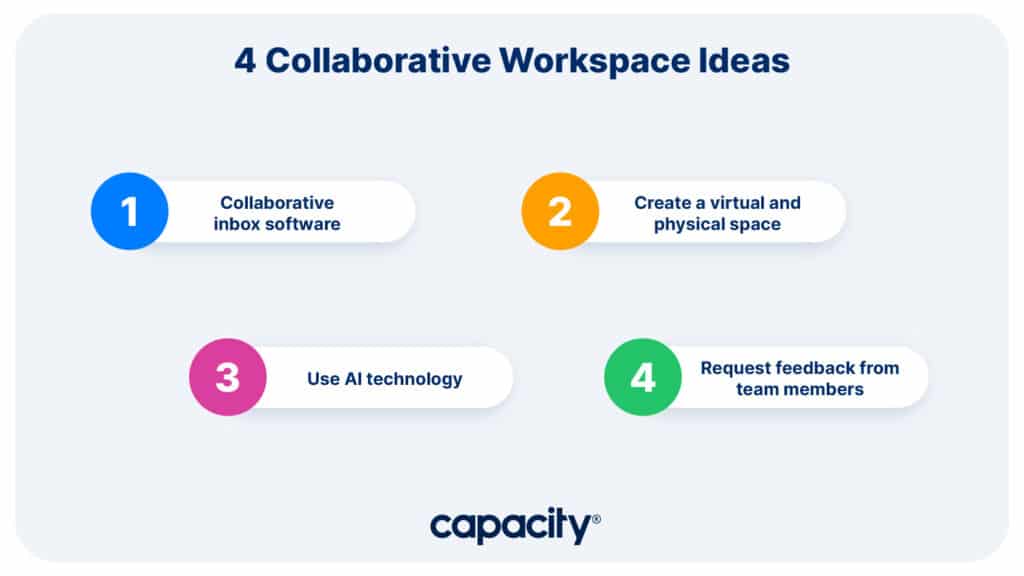
4 Collaborative workspace ideas
Here are some ideas you can use to improve collaboration in your business:
Collaborative inbox software
Imagine a workspace where everyone can access the same set of incoming emails, simultaneously respond to them, assign tasks to team members, and leave notes for each other. Collaborative inbox software allows teams to achieve this level of collaboration and efficiency. It’s like having a shared inbox as a central hub for all communication.
With this software, businesses can eliminate the hassle of forwarding emails, searching for lost messages, and getting caught up in long email chains. Instead, they can work together in a dynamic, responsive environment that fosters teamwork and productivity.
Create a virtual and physical space
Are you tired of feeling disconnected from your team while working remotely? It’s time to take collaboration to the next level with a collaborative workspace that bridges the gap between virtual and physical settings. By creating a space that caters to both, businesses can improve collaboration among team members like never before.
Picture a virtual whiteboard where everyone can contribute their ideas or a physical room with a large table where brainstorming and planning sessions can take place. It’s all about tearing down the barriers that separate us and embracing a new way of working together.
Use AI technology
Collaboration is the backbone of a strong and successful business. But with ever-changing technologies and work environments, it can be difficult to bring everyone together in a truly collaborative workspace. That’s where AI comes in.
With its ability to streamline workflows, automate routine tasks, and gather insights from vast amounts of data, AI technology can help businesses to create a more collaborative work environment. By using AI-powered tools and software, companies can foster more efficient communication, break down silos between departments, and empower their teams to work together in new and exciting ways. From project management to customer service, the possibilities are endless.
Platforms like Capacity can help streamline tedious tasks for businesses looking to scale customer and internal support. Capacity helps businesses deflect over 90% of tickets away from support teams.

Automate Your Work
Capacity’s enterprise AI chatbot can help:
- Answer FAQs anytime, anywhere
- Find relevant documents within seconds
- Give surveys and collect feedback
Request feedback from team members
As businesses continue to evolve, it’s important to create a collaborative workspace that fosters creativity, productivity, and innovation. But how do you know if your team members are truly on board with the changes you’re making? One way to find out is by requesting feedback from your team.
Don’t be afraid to ask for their thoughts and opinions on the new workspace design. After all, they are the ones who will be using it day in and day out. Encourage open and honest communication, and be prepared to make changes based on their feedback. By involving your team in the process, you’ll not only create a workspace that works for everyone, but you’ll also build trust and respect among your team members.
What does a collaborative workspace look like?
What makes a good collaborative space? They can look different depending on where you’re working. Here’s a breakdown of how a collaborative office space could look in three scenarios:

Virtual collaborative workspace
Remote work has become common in recent years. Here are a few examples of virtual collaborative workspace features:
- Interactive team screen sharing
- Virtual brainstorming sessions
- Asynchronous document editing
Hybrid collaborative workspace
Many companies have chosen to move to a hybrid model. Here are a few examples of hybrid collaborative workspace features:
- Plan in-office strategy meetings
- Go remote for deep work that requires focus
- Schedule in-person weekly team meetings
- Borrow what works best from both remote and hybrid workspaces
In-person collaborative workspace
And finally, a few examples of in-person collaborative workspace ideas:
- Ensure a mix of private and public spaces
- Utilize rooms with video conferencing and sharing capabilities
- Spend time white-boarding and brainstorming
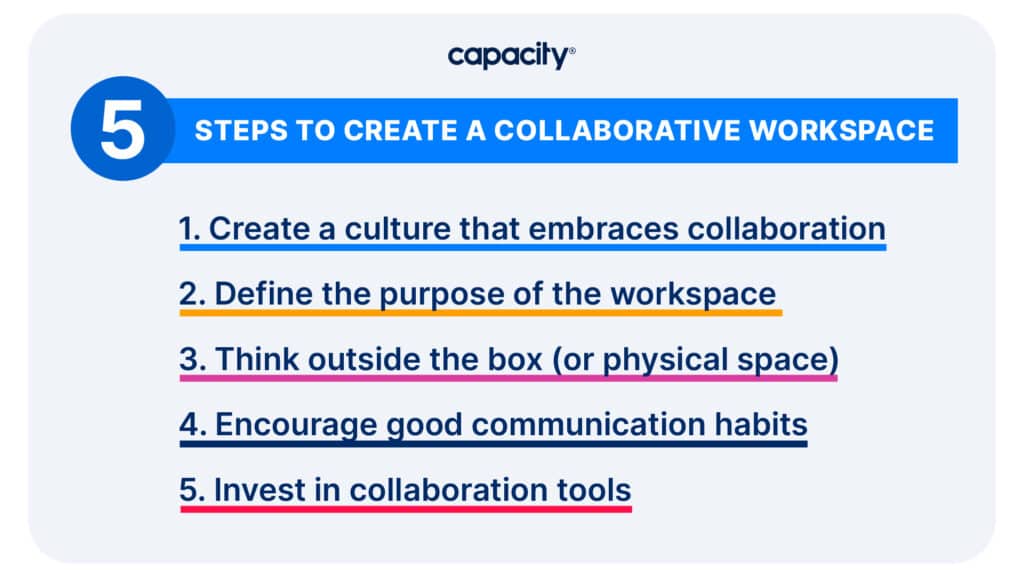
How to create a collaborative workspace in 5 steps
Ready to create a collaborative workspace? Here are five steps you can follow:
1. Create a culture that embraces collaboration
Changing company culture is not easy, but essential to building a workspace that invites collaboration. Encouraging collaboration gives everyone a voice and keeps each person in the loop. Effective communication is key and can be done remotely or in person.
2. Define the Purpose of the Workspace
Before you can create a collaborative workspace, you need to define the purpose of the workspace. Here are some questions to get you thinking:
- What is the workspace going to be used for?
- Will it be used for team meetings? For individual work? For both?
- How will teams work within the space?
Once you have a clear idea of the purpose of the workspace, you can start to design it accordingly.
3. Think outside the box (or physical space)
What’s the number one thing that would make you most satisfied at your job? According to a WeWork survey, most people favor workspace and amenities over pay and vacation time.
Stale conference rooms are quickly becoming outdated. Think about other ways to bring employees together, such as an in-office cafe or game room. Collaboration spaces can be more than just sitting in a bland boardroom.
4. Encourage Good Communication Habits
One of the most important things you can do to encourage collaboration in the workplace is to encourage good communication habits. This means creating an environment where team members feel comfortable sharing ideas and giving feedback.
5. Invest in collaboration tools
A collaborative workspace requires new tools to get started. Getting teams to adopt new technology can be challenging, but easing into it can set your team up for success. Tools such as Donut can bring people together over a virtual “donut” to encourage cross-functional team building.
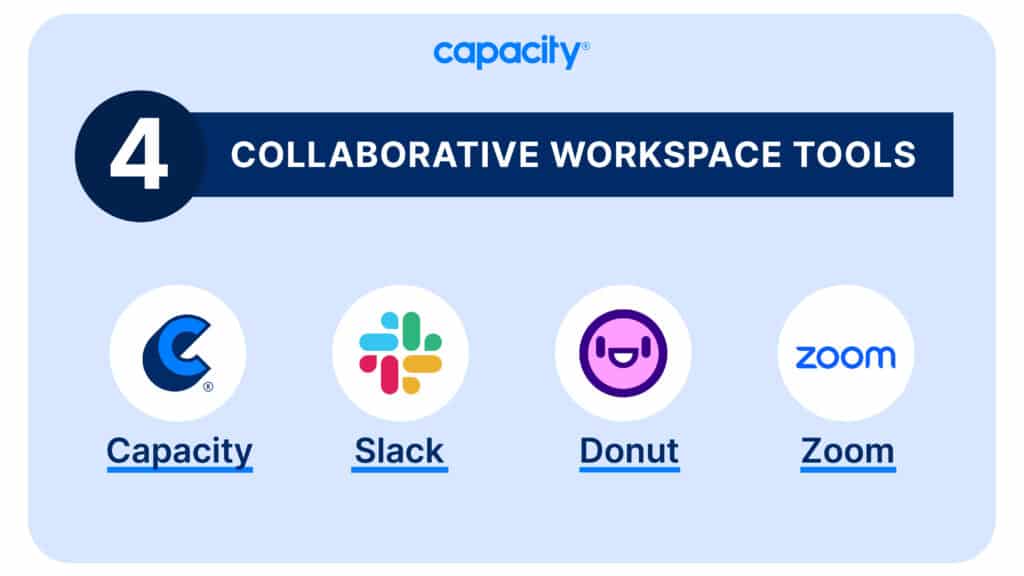
4 examples of collaborative workspace tools
When creating a collaborative workspace, deciding which tools to use can vary depending on your organization’s needs. Here are a few of the top tools you can add to your tech stack to promote collaboration in your workspace:
Capacity
We may be slightly biased, but we think Capacity is awesome. Capacity is a platform that automates support for internal teams and external customers. The platform handles repetitive tasks, freeing teams to focus on strategic, collaborative projects.
Capacity answers repetitive FAQs wherever and whenever. Find information within seconds by typing a question or prompt in Slack or Microsoft Teams and receive an answer instantly.
Bonus – You can try Capacity for free!
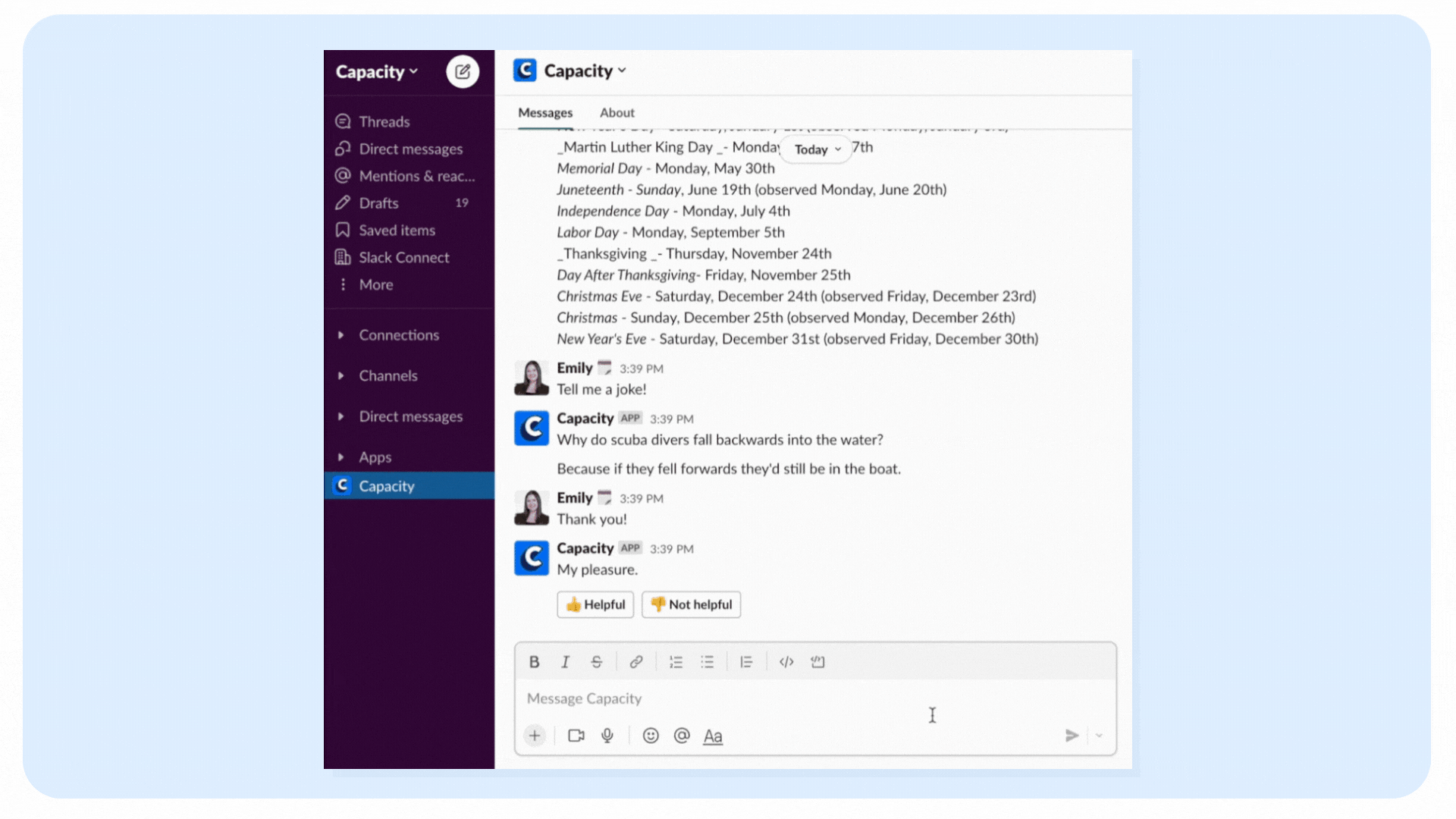
Slack
If you work in tech, you know Slack, an instant messaging program owned by Salesforce. Slack was developed for professional, organized group messaging and is the primary communication method for thousands of organizations.
Donut
Donut virtual coffee is a useful Slack integration. It brings employees together by facilitating new connections, bringing together random workers from different parts of the organization.
Zoom
By this point, we have all heard of Zoom and/or have used it at some point. And for good reason! Zoom is a video software program developed by Zoom Video Communications. It allows users to communicate through video conferencing, screen sharing, and webinars.
Help your business become more collaborative with Capacity – Try it for free today!





